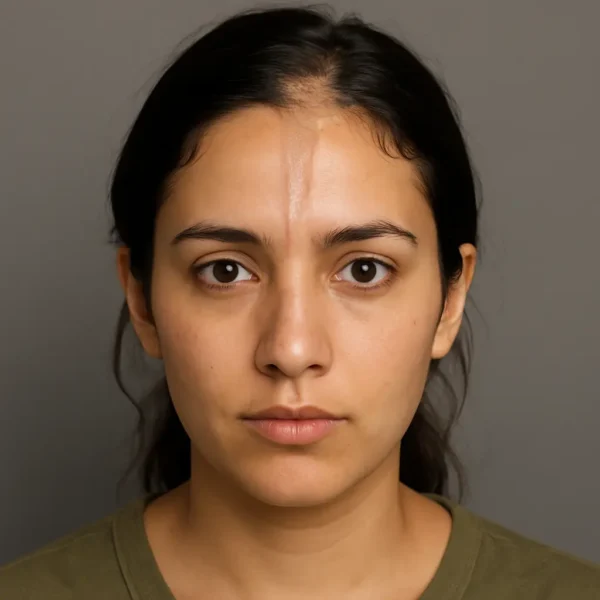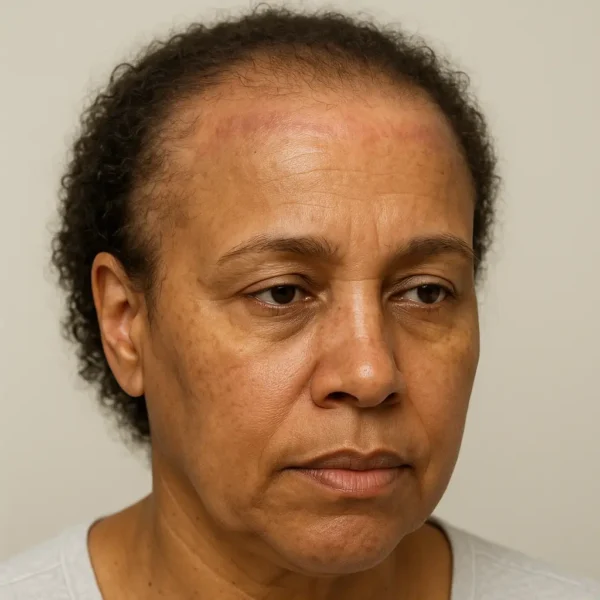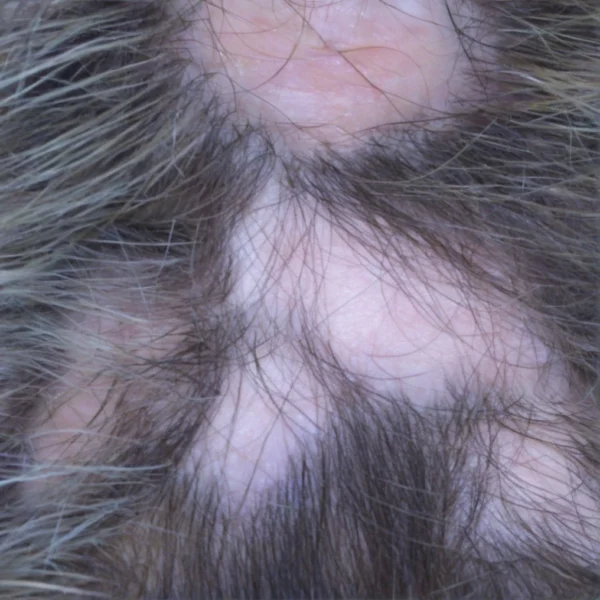Localized scleroderma (also called morphea) is an immune-driven condition that makes the skin and nearby tissues thicken and harden. When it appears as a narrow, downward-running streak across the forehead and into the scalp, it’s called en coup de sabre – French for “sword strike,” because the groove can look like a healed cut. This form can reach deeper layers under the skin and, in some people, links with a related condition called Parry–Romberg syndrome, which causes gradual thinning on one side of the face. Hair loss in en coup de sabre is usually scarring, meaning follicles can be permanently damaged if inflammation is not calmed early.
Who gets it and how does it behave: En coup de sabre is rare. It affects both children and adults, with many cases starting in childhood, and it is reported more often in girls and women. It often begins as a pale or slightly purple linear patch on the forehead that slowly marches back into the scalp. Over months to a few years, the active phase tends to “burn out,” leaving a fixed band of thinner skin and a strip of hair loss. Some people have flares or a longer course. Headaches, seizures, or other neurologic symptoms can occur on the same side as the skin changes and deserve prompt medical attention.
Why does it cause hair loss: In the early phase, the immune system targets small blood vessels and structures in the skin, including hair follicles. Over time, the body lays down extra collagen (scar-like tissue). On the scalp, this process squeezes and starves hair follicles, then replaces them with dense, smooth scar tissue. Once that scarring is in place, the lost hair usually does not grow back. This is why recognizing active disease and treating it early is so important.
What does it look like: On the scalp, en coup de sabre appears as a narrow, firm, and slightly indented band with a smooth, ivory-colored surface. You may see a visible groove or depression if the tissue underneath has also thinned. Doctors often use a handheld scope (trichoscopy) to look for clues of scarring, such as missing follicle openings and white, shiny areas. These bedside tools, together with good photographs taken over time, help track whether the condition is still active or has settled down.
Do I need a biopsy or scans: A small skin biopsy from the active edge can confirm the diagnosis when there’s doubt. Under the microscope, early lesions show inflammation around hair follicles and blood vessels; later lesions show thick bands of collagen with few if any follicles left – typical of scarring alopecia. If you have headaches, seizures, vision changes, or very extensive forehead/scalp involvement, your care team may request a brain MRI and an eye exam, because en coup de sabre can occasionally affect the brain and eyes on the same side.
What else can look like this: Other causes of scarring hair loss can sometimes line up in a streak and mimic en coup de sabre . These include lichen planopilaris and discoid lupus, and rarely scars from past injuries. The location (forehead into scalp), the firm induration (hardening), the groove, and any same-side neurologic or eye symptoms point more strongly to en coup de sabre . When the picture isn’t clear, biopsy settles the question.
How do doctors evaluate it: A practical approach your dermatology team may follow:
Careful mapping of the lesion – feel for firmness and outline the borders.Photos and trichoscopy – to document change over time.Biopsy – if the diagnosis is uncertain or the pattern is unusual.Screen for related problems – focused questions and exam for headaches, seizures, or vision changes; MRI and eye assessment if symptoms or extent suggest risk.Track activity – simple activity scores used in morphea clinics help guide treatment and timing. What are the treatment goals: There are two main goals with treatment:
Stop activity – calm the inflammation quickly to prevent more scarring and hair loss.Repair appearance – once the disease has been quiet for a long stretch, plan staged reconstruction to improve contour and camouflage the alopecia. Starting effective treatment early improves the chances of protecting remaining follicles.
Which treatments are used to control active disease: The regimen most often recommended for active en coup de sabre is methotrexate combined with systemic corticosteroids at the start. Steroids act quickly to prevent inflammation; methotrexate maintains control and lowers the risk of relapse. Doctors usually continue methotrexate for many months after the lesion becomes inactive. If methotrexate isn’t tolerated or doesn’t work well enough, mycophenolate mofetil is a common alternative used in specialty centers.
Topical or injected steroids and calcineurin inhibitors can help at the edges of a small, mild lesion, but they are rarely enough on their own once the streak is progressing. Phototherapy (UVA1) has a stronger track record for broader plaque-type morphea; its value for deep linear lesions on the head is more limited and needs case-by-case judgment.
What’s the evidence like: Most data come from observational studies and expert consensus rather than large randomized trials. That said, pediatric and adult cohorts consistently show that methotrexate with a steroid “bridge” is effective at stopping activity, and earlier use is linked with better outcomes.
How do we know treatment is working: Signs that activity is quieting include softening of the firm band, fading of any purple edge, no further spread, and stabilization of hair loss. Under trichoscopy, doctors look for the absence of ongoing follicle loss. If there is known brain involvement, imaging follow-up is tailored to the individual. Once scarring has formed, meaningful hair regrowth is uncommon, so success is often measured by preventing more loss and by planning cosmetic repair.
What can be done once it’s inactive: When the disease has been stable – no new spread or hardening – for at least 1 to 2 years, reconstructive options can be considered:
Fat grafting to improve soft-tissue contour.Scar revision or, for narrow bands, tissue expansion with surgical removal of the tightest segment.Hair restoration in carefully selected cases. Transplanting hair can work if the skin has a good blood supply and the disease is truly quiet. Surgeons usually proceed in small, staged steps to confirm graft survival and avoid provoking a flare. A multidisciplinary team (dermatology, rheumatology, neurology/ophthalmology as needed, and plastic/hair surgery) offers the safest planning and execution.
What should patients and families know : Some key items that are good to know about include:
Act early. New or spreading lesions deserve prompt dermatology referral. Early systemic therapy protects follicles.Expect some scarring. Even after activity stops, the streak and hair loss often remain; cosmetic repair is possible but takes time and careful staging.Watch for neurologic or eye symptoms. Headaches, seizures, or vision changes – especially on the same side – should be reported quickly.Think long-term. Treatment often continues beyond the active phase to prevent relapse. Regular follow-up is important. Conclusions: En coup de sabre is an uncommon but impactful cause of scarring hair loss across the forehead and scalp. It starts with inflammation that harms hair follicles and ends with scar tissue that won’t regrow hair. Because of that, the most important steps are recognizing activity early and starting effective treatment – most often methotrexate with a short-term course of systemic steroids. When the condition has been inactive for a long time, staged procedures – fat grafting, scar surgery, and sometimes hair transplantation – can improve the look and help hide the alopecia. With timely care and a coordinated team, many people can prevent further hair loss and achieve meaningful cosmetic improvement.
Bibliography
11711645 {11711645:3N7DK8YK},{11711645:RDLZAV2L},{11711645:EMZ764JD},{11711645:CSWQ4UFV},{11711645:VCKU7PSK},{11711645:YTKDNCCZ},{11711645:76IAD3SV},{11711645:T5XQT5H8},{11711645:AYYA69HZ},{11711645:T3GFHEZY},{11711645:6774633V},{11711645:8WMWIGRD},{11711645:ATQIBKGK},{11711645:WTA4CAKZ},{11711645:B9BFR5RX},{11711645:B9LDSM6H},{11711645:9ZT698WV},{11711645:6FMLZE97},{11711645:F8ZXBATL} 1 vancouver 50 date asc 1947 https://www.keratin.com/wp-content/plugins/zotpress/ %7B%22status%22%3A%22success%22%2C%22updateneeded%22%3Afalse%2C%22instance%22%3Afalse%2C%22meta%22%3A%7B%22request_last%22%3A0%2C%22request_next%22%3A0%2C%22used_cache%22%3Atrue%7D%2C%22data%22%3A%5B%7B%22key%22%3A%22T5XQT5H8%22%2C%22library%22%3A%7B%22id%22%3A11711645%7D%2C%22meta%22%3A%7B%22creatorSummary%22%3A%22Dilley%20and%20Perry%22%2C%22parsedDate%22%3A%221968-06%22%2C%22numChildren%22%3A0%7D%2C%22bib%22%3A%22%26lt%3Bdiv%20class%3D%26quot%3Bcsl-bib-body%26quot%3B%20style%3D%26quot%3Bline-height%3A%201.35%3B%20%26quot%3B%26gt%3B%5Cn%20%20%26lt%3Bdiv%20class%3D%26quot%3Bcsl-entry%26quot%3B%20style%3D%26quot%3Bclear%3A%20left%3B%20%26quot%3B%26gt%3B%5Cn%20%20%20%20%26lt%3Bdiv%20class%3D%26quot%3Bcsl-left-margin%26quot%3B%20style%3D%26quot%3Bfloat%3A%20left%3B%20padding-right%3A%200.5em%3B%20text-align%3A%20right%3B%20width%3A%201em%3B%26quot%3B%26gt%3B1.%26lt%3B%5C%2Fdiv%26gt%3B%26lt%3Bdiv%20class%3D%26quot%3Bcsl-right-inline%26quot%3B%20style%3D%26quot%3Bmargin%3A%200%20.4em%200%201.5em%3B%26quot%3B%26gt%3BDilley%20JJ%2C%20Perry%20HO.%20Bilateral%20linear%20scleroderma%20en%20coup%20de%20sabre.%20Arch%20Dermatol.%201968%20June%3B97%286%29%3A688%26%23x2013%3B9.%26lt%3B%5C%2Fdiv%26gt%3B%5Cn%20%20%20%26lt%3B%5C%2Fdiv%26gt%3B%5Cn%26lt%3B%5C%2Fdiv%26gt%3B%22%2C%22data%22%3A%7B%22itemType%22%3A%22journalArticle%22%2C%22title%22%3A%22Bilateral%20linear%20scleroderma%20en%20coup%20de%20sabre%22%2C%22creators%22%3A%5B%7B%22creatorType%22%3A%22author%22%2C%22firstName%22%3A%22J.%20J.%22%2C%22lastName%22%3A%22Dilley%22%7D%2C%7B%22creatorType%22%3A%22author%22%2C%22firstName%22%3A%22H.%20O.%22%2C%22lastName%22%3A%22Perry%22%7D%5D%2C%22abstractNote%22%3A%22%22%2C%22date%22%3A%221968-06%22%2C%22language%22%3A%22eng%22%2C%22DOI%22%3A%22%22%2C%22ISSN%22%3A%220003-987X%22%2C%22url%22%3A%22%22%2C%22collections%22%3A%5B%22KU6TJMQP%22%5D%2C%22dateModified%22%3A%222025-09-24T16%3A42%3A44Z%22%7D%7D%2C%7B%22key%22%3A%2276IAD3SV%22%2C%22library%22%3A%7B%22id%22%3A11711645%7D%2C%22meta%22%3A%7B%22creatorSummary%22%3A%22Hazen%20and%20Askari%22%2C%22parsedDate%22%3A%221979-07%22%2C%22numChildren%22%3A0%7D%2C%22bib%22%3A%22%26lt%3Bdiv%20class%3D%26quot%3Bcsl-bib-body%26quot%3B%20style%3D%26quot%3Bline-height%3A%201.35%3B%20%26quot%3B%26gt%3B%5Cn%20%20%26lt%3Bdiv%20class%3D%26quot%3Bcsl-entry%26quot%3B%20style%3D%26quot%3Bclear%3A%20left%3B%20%26quot%3B%26gt%3B%5Cn%20%20%20%20%26lt%3Bdiv%20class%3D%26quot%3Bcsl-left-margin%26quot%3B%20style%3D%26quot%3Bfloat%3A%20left%3B%20padding-right%3A%200.5em%3B%20text-align%3A%20right%3B%20width%3A%201em%3B%26quot%3B%26gt%3B1.%26lt%3B%5C%2Fdiv%26gt%3B%26lt%3Bdiv%20class%3D%26quot%3Bcsl-right-inline%26quot%3B%20style%3D%26quot%3Bmargin%3A%200%20.4em%200%201.5em%3B%26quot%3B%26gt%3BHazen%20PG%2C%20Askari%20A.%20Localized%20scleroderma%20with%20cutaneous%20calcinosis.%20A%20distinctive%20variant.%20Arch%20Dermatol.%201979%20July%3B115%287%29%3A871%26%23x2013%3B2.%26lt%3B%5C%2Fdiv%26gt%3B%5Cn%20%20%20%26lt%3B%5C%2Fdiv%26gt%3B%5Cn%26lt%3B%5C%2Fdiv%26gt%3B%22%2C%22data%22%3A%7B%22itemType%22%3A%22journalArticle%22%2C%22title%22%3A%22Localized%20scleroderma%20with%20cutaneous%20calcinosis.%20A%20distinctive%20variant%22%2C%22creators%22%3A%5B%7B%22creatorType%22%3A%22author%22%2C%22firstName%22%3A%22P.%20G.%22%2C%22lastName%22%3A%22Hazen%22%7D%2C%7B%22creatorType%22%3A%22author%22%2C%22firstName%22%3A%22A.%22%2C%22lastName%22%3A%22Askari%22%7D%5D%2C%22abstractNote%22%3A%22Two%20patients%20had%20a%20distinctive%20variant%20of%20localized%20scleroderma.%20Both%20have%20a%20history%20of%20sclerodermatous%20changes%20of%20the%20skin%20over%20the%20face%20developing%20relatively%20late%20in%20life%20and%20accompanied%20by%20hair%20loss%2C%20cutaneous%20calcification%2C%20and%20prominent%20beaking%20of%20the%20nose.%20A%20striking%20lack%20of%20systemic%20involvement%20also%20was%20noted.%22%2C%22date%22%3A%221979-07%22%2C%22language%22%3A%22eng%22%2C%22DOI%22%3A%22%22%2C%22ISSN%22%3A%220003-987X%22%2C%22url%22%3A%22%22%2C%22collections%22%3A%5B%22KU6TJMQP%22%5D%2C%22dateModified%22%3A%222025-09-24T16%3A43%3A27Z%22%7D%7D%2C%7B%22key%22%3A%22YTKDNCCZ%22%2C%22library%22%3A%7B%22id%22%3A11711645%7D%2C%22meta%22%3A%7B%22creatorSummary%22%3A%22Serup%20et%20al.%22%2C%22parsedDate%22%3A%221984-03%22%2C%22numChildren%22%3A0%7D%2C%22bib%22%3A%22%26lt%3Bdiv%20class%3D%26quot%3Bcsl-bib-body%26quot%3B%20style%3D%26quot%3Bline-height%3A%201.35%3B%20%26quot%3B%26gt%3B%5Cn%20%20%26lt%3Bdiv%20class%3D%26quot%3Bcsl-entry%26quot%3B%20style%3D%26quot%3Bclear%3A%20left%3B%20%26quot%3B%26gt%3B%5Cn%20%20%20%20%26lt%3Bdiv%20class%3D%26quot%3Bcsl-left-margin%26quot%3B%20style%3D%26quot%3Bfloat%3A%20left%3B%20padding-right%3A%200.5em%3B%20text-align%3A%20right%3B%20width%3A%201em%3B%26quot%3B%26gt%3B1.%26lt%3B%5C%2Fdiv%26gt%3B%26lt%3Bdiv%20class%3D%26quot%3Bcsl-right-inline%26quot%3B%20style%3D%26quot%3Bmargin%3A%200%20.4em%200%201.5em%3B%26quot%3B%26gt%3BSerup%20J%2C%20Serup%20L%2C%20Sj%26%23xF6%3B%20O.%20Localized%20scleroderma%20%26%23x201C%3Ben%20coup%20de%20sabre%26%23x201D%3B%20with%20external%20eye%20muscle%20involvement%20at%20the%20same%20line.%20Clin%20Exp%20Dermatol.%201984%20Mar%3B9%282%29%3A196%26%23x2013%3B200.%26lt%3B%5C%2Fdiv%26gt%3B%5Cn%20%20%20%26lt%3B%5C%2Fdiv%26gt%3B%5Cn%26lt%3B%5C%2Fdiv%26gt%3B%22%2C%22data%22%3A%7B%22itemType%22%3A%22journalArticle%22%2C%22title%22%3A%22Localized%20scleroderma%20%27en%20coup%20de%20sabre%27%20with%20external%20eye%20muscle%20involvement%20at%20the%20same%20line%22%2C%22creators%22%3A%5B%7B%22creatorType%22%3A%22author%22%2C%22firstName%22%3A%22J.%22%2C%22lastName%22%3A%22Serup%22%7D%2C%7B%22creatorType%22%3A%22author%22%2C%22firstName%22%3A%22L.%22%2C%22lastName%22%3A%22Serup%22%7D%2C%7B%22creatorType%22%3A%22author%22%2C%22firstName%22%3A%22O.%22%2C%22lastName%22%3A%22Sj%5Cu00f6%22%7D%5D%2C%22abstractNote%22%3A%22%22%2C%22date%22%3A%221984-03%22%2C%22language%22%3A%22eng%22%2C%22DOI%22%3A%2210.1111%5C%2Fj.1365-2230.1984.tb00783.x%22%2C%22ISSN%22%3A%220307-6938%22%2C%22url%22%3A%22%22%2C%22collections%22%3A%5B%22KU6TJMQP%22%5D%2C%22dateModified%22%3A%222025-09-24T16%3A44%3A07Z%22%7D%7D%2C%7B%22key%22%3A%22VCKU7PSK%22%2C%22library%22%3A%7B%22id%22%3A11711645%7D%2C%22meta%22%3A%7B%22creatorSummary%22%3A%22Goldenstein-Schainberg%20et%20al.%22%2C%22parsedDate%22%3A%221990-10%22%2C%22numChildren%22%3A0%7D%2C%22bib%22%3A%22%26lt%3Bdiv%20class%3D%26quot%3Bcsl-bib-body%26quot%3B%20style%3D%26quot%3Bline-height%3A%201.35%3B%20%26quot%3B%26gt%3B%5Cn%20%20%26lt%3Bdiv%20class%3D%26quot%3Bcsl-entry%26quot%3B%20style%3D%26quot%3Bclear%3A%20left%3B%20%26quot%3B%26gt%3B%5Cn%20%20%20%20%26lt%3Bdiv%20class%3D%26quot%3Bcsl-left-margin%26quot%3B%20style%3D%26quot%3Bfloat%3A%20left%3B%20padding-right%3A%200.5em%3B%20text-align%3A%20right%3B%20width%3A%201em%3B%26quot%3B%26gt%3B1.%26lt%3B%5C%2Fdiv%26gt%3B%26lt%3Bdiv%20class%3D%26quot%3Bcsl-right-inline%26quot%3B%20style%3D%26quot%3Bmargin%3A%200%20.4em%200%201.5em%3B%26quot%3B%26gt%3BGoldenstein-Schainberg%20C%2C%20Pereira%20RM%2C%20Gusukuma%20MC%2C%20Messina%20WC%2C%20Cossermelli%20W.%20Childhood%20linear%20scleroderma%20%26%23x201C%3Ben%20coup%20de%20sabre%26%23x201D%3B%20with%20uveitis.%20J%20Pediatr.%201990%20Oct%3B117%284%29%3A581%26%23x2013%3B4.%26lt%3B%5C%2Fdiv%26gt%3B%5Cn%20%20%20%26lt%3B%5C%2Fdiv%26gt%3B%5Cn%26lt%3B%5C%2Fdiv%26gt%3B%22%2C%22data%22%3A%7B%22itemType%22%3A%22journalArticle%22%2C%22title%22%3A%22Childhood%20linear%20scleroderma%20%5C%22en%20coup%20de%20sabre%5C%22%20with%20uveitis%22%2C%22creators%22%3A%5B%7B%22creatorType%22%3A%22author%22%2C%22firstName%22%3A%22C.%22%2C%22lastName%22%3A%22Goldenstein-Schainberg%22%7D%2C%7B%22creatorType%22%3A%22author%22%2C%22firstName%22%3A%22R.%20M.%22%2C%22lastName%22%3A%22Pereira%22%7D%2C%7B%22creatorType%22%3A%22author%22%2C%22firstName%22%3A%22M.%20C.%22%2C%22lastName%22%3A%22Gusukuma%22%7D%2C%7B%22creatorType%22%3A%22author%22%2C%22firstName%22%3A%22W.%20C.%22%2C%22lastName%22%3A%22Messina%22%7D%2C%7B%22creatorType%22%3A%22author%22%2C%22firstName%22%3A%22W.%22%2C%22lastName%22%3A%22Cossermelli%22%7D%5D%2C%22abstractNote%22%3A%22%22%2C%22date%22%3A%221990-10%22%2C%22language%22%3A%22eng%22%2C%22DOI%22%3A%2210.1016%5C%2Fs0022-3476%2805%2980693-6%22%2C%22ISSN%22%3A%220022-3476%22%2C%22url%22%3A%22%22%2C%22collections%22%3A%5B%22KU6TJMQP%22%5D%2C%22dateModified%22%3A%222025-09-24T16%3A44%3A45Z%22%7D%7D%2C%7B%22key%22%3A%22CSWQ4UFV%22%2C%22library%22%3A%7B%22id%22%3A11711645%7D%2C%22meta%22%3A%7B%22creatorSummary%22%3A%22Soma%20and%20Fujimoto%22%2C%22parsedDate%22%3A%221998-02%22%2C%22numChildren%22%3A0%7D%2C%22bib%22%3A%22%26lt%3Bdiv%20class%3D%26quot%3Bcsl-bib-body%26quot%3B%20style%3D%26quot%3Bline-height%3A%201.35%3B%20%26quot%3B%26gt%3B%5Cn%20%20%26lt%3Bdiv%20class%3D%26quot%3Bcsl-entry%26quot%3B%20style%3D%26quot%3Bclear%3A%20left%3B%20%26quot%3B%26gt%3B%5Cn%20%20%20%20%26lt%3Bdiv%20class%3D%26quot%3Bcsl-left-margin%26quot%3B%20style%3D%26quot%3Bfloat%3A%20left%3B%20padding-right%3A%200.5em%3B%20text-align%3A%20right%3B%20width%3A%201em%3B%26quot%3B%26gt%3B1.%26lt%3B%5C%2Fdiv%26gt%3B%26lt%3Bdiv%20class%3D%26quot%3Bcsl-right-inline%26quot%3B%20style%3D%26quot%3Bmargin%3A%200%20.4em%200%201.5em%3B%26quot%3B%26gt%3BSoma%20Y%2C%20Fujimoto%20M.%20Frontoparietal%20scleroderma%20%28en%20coup%20de%20sabre%29%20following%20Blaschko%26%23x2019%3Bs%20lines.%20J%20Am%20Acad%20Dermatol.%201998%20Feb%3B38%282%20Pt%202%29%3A366%26%23x2013%3B8.%26lt%3B%5C%2Fdiv%26gt%3B%5Cn%20%20%20%26lt%3B%5C%2Fdiv%26gt%3B%5Cn%26lt%3B%5C%2Fdiv%26gt%3B%22%2C%22data%22%3A%7B%22itemType%22%3A%22journalArticle%22%2C%22title%22%3A%22Frontoparietal%20scleroderma%20%28en%20coup%20de%20sabre%29%20following%20Blaschko%27s%20lines%22%2C%22creators%22%3A%5B%7B%22creatorType%22%3A%22author%22%2C%22firstName%22%3A%22Y.%22%2C%22lastName%22%3A%22Soma%22%7D%2C%7B%22creatorType%22%3A%22author%22%2C%22firstName%22%3A%22M.%22%2C%22lastName%22%3A%22Fujimoto%22%7D%5D%2C%22abstractNote%22%3A%22We%20describe%20three%20patients%20with%20frontoparietal%20scleroderma%20showing%20multiple%20lesions.%20The%20lesions%20were%20in%20two%20different%20lines%20that%20seemed%20to%20belong%20to%20Blaschko%26%23039%3Bs%20lines.%20It%20remains%20controversial%20whether%20linear%20scleroderma%20follows%20Blaschko%26%23039%3Bs%20lines%2C%20but%20our%20observations%20presented%20here%20suggest%20that%20frontoparietal%20scleroderma%20occurs%20along%20the%20lines%20of%20Blaschko.%22%2C%22date%22%3A%221998-02%22%2C%22language%22%3A%22eng%22%2C%22DOI%22%3A%2210.1016%5C%2Fs0190-9622%2898%2970586-9%22%2C%22ISSN%22%3A%220190-9622%22%2C%22url%22%3A%22%22%2C%22collections%22%3A%5B%22KU6TJMQP%22%5D%2C%22dateModified%22%3A%222025-09-24T16%3A45%3A53Z%22%7D%7D%2C%7B%22key%22%3A%22EMZ764JD%22%2C%22library%22%3A%7B%22id%22%3A11711645%7D%2C%22meta%22%3A%7B%22creatorSummary%22%3A%22McKenna%20and%20Benton%22%2C%22parsedDate%22%3A%221999-11%22%2C%22numChildren%22%3A0%7D%2C%22bib%22%3A%22%26lt%3Bdiv%20class%3D%26quot%3Bcsl-bib-body%26quot%3B%20style%3D%26quot%3Bline-height%3A%201.35%3B%20%26quot%3B%26gt%3B%5Cn%20%20%26lt%3Bdiv%20class%3D%26quot%3Bcsl-entry%26quot%3B%20style%3D%26quot%3Bclear%3A%20left%3B%20%26quot%3B%26gt%3B%5Cn%20%20%20%20%26lt%3Bdiv%20class%3D%26quot%3Bcsl-left-margin%26quot%3B%20style%3D%26quot%3Bfloat%3A%20left%3B%20padding-right%3A%200.5em%3B%20text-align%3A%20right%3B%20width%3A%201em%3B%26quot%3B%26gt%3B1.%26lt%3B%5C%2Fdiv%26gt%3B%26lt%3Bdiv%20class%3D%26quot%3Bcsl-right-inline%26quot%3B%20style%3D%26quot%3Bmargin%3A%200%20.4em%200%201.5em%3B%26quot%3B%26gt%3BMcKenna%20DB%2C%20Benton%20EC.%20A%20tri-linear%20pattern%20of%20scleroderma%20%26%23x201C%3Ben%20coup%20de%20sabre%26%23x201D%3B%20following%20Blaschko%26%23x2019%3Bs%20lines.%20Clin%20Exp%20Dermatol.%201999%20Nov%3B24%286%29%3A467%26%23x2013%3B8.%26lt%3B%5C%2Fdiv%26gt%3B%5Cn%20%20%20%26lt%3B%5C%2Fdiv%26gt%3B%5Cn%26lt%3B%5C%2Fdiv%26gt%3B%22%2C%22data%22%3A%7B%22itemType%22%3A%22journalArticle%22%2C%22title%22%3A%22A%20tri-linear%20pattern%20of%20scleroderma%20%27en%20coup%20de%20sabre%27%20following%20Blaschko%27s%20lines%22%2C%22creators%22%3A%5B%7B%22creatorType%22%3A%22author%22%2C%22firstName%22%3A%22D.%20B.%22%2C%22lastName%22%3A%22McKenna%22%7D%2C%7B%22creatorType%22%3A%22author%22%2C%22firstName%22%3A%22E.%20C.%22%2C%22lastName%22%3A%22Benton%22%7D%5D%2C%22abstractNote%22%3A%22Linear%20scleroderma%20%26%23039%3Ben%20coup%20de%20sabre%26%23039%3B%20is%20characterized%20by%20atrophy%20and%20furrowing%20of%20the%20skin%20of%20the%20frontoparietal%20region.%20In%20most%20cases%20it%20occurs%20as%20a%20single%2C%20paramedian%20line%20that%20may%20be%20associated%20with%20hypoplasia%20of%20underlying%20structures%20and%20hemiatrophy%20of%20the%20face.%20Rarely%2C%20lesions%20form%20two%20lines%2C%20either%20both%20on%20the%20same%20side%20or%20bilaterally.%20We%20describe%20an%2018-year-old%20male%20with%20an%20unusual%20tri-linear%20pattern%20of%20scleroderma%20%26%23039%3Ben%20coup%20de%20sabre%26%23039%3B%20following%20Blaschko%26%23039%3Bs%20lines.%22%2C%22date%22%3A%221999-11%22%2C%22language%22%3A%22eng%22%2C%22DOI%22%3A%2210.1046%5C%2Fj.1365-2230.1999.00535.x%22%2C%22ISSN%22%3A%220307-6938%22%2C%22url%22%3A%22%22%2C%22collections%22%3A%5B%22KU6TJMQP%22%5D%2C%22dateModified%22%3A%222025-09-24T16%3A46%3A30Z%22%7D%7D%2C%7B%22key%22%3A%223N7DK8YK%22%2C%22library%22%3A%7B%22id%22%3A11711645%7D%2C%22meta%22%3A%7B%22creatorSummary%22%3A%22Patrizi%20et%20al.%22%2C%22parsedDate%22%3A%222000-05%22%2C%22numChildren%22%3A0%7D%2C%22bib%22%3A%22%26lt%3Bdiv%20class%3D%26quot%3Bcsl-bib-body%26quot%3B%20style%3D%26quot%3Bline-height%3A%201.35%3B%20%26quot%3B%26gt%3B%5Cn%20%20%26lt%3Bdiv%20class%3D%26quot%3Bcsl-entry%26quot%3B%20style%3D%26quot%3Bclear%3A%20left%3B%20%26quot%3B%26gt%3B%5Cn%20%20%20%20%26lt%3Bdiv%20class%3D%26quot%3Bcsl-left-margin%26quot%3B%20style%3D%26quot%3Bfloat%3A%20left%3B%20padding-right%3A%200.5em%3B%20text-align%3A%20right%3B%20width%3A%201em%3B%26quot%3B%26gt%3B1.%26lt%3B%5C%2Fdiv%26gt%3B%26lt%3Bdiv%20class%3D%26quot%3Bcsl-right-inline%26quot%3B%20style%3D%26quot%3Bmargin%3A%200%20.4em%200%201.5em%3B%26quot%3B%26gt%3BPatrizi%20A%2C%20Marzaduri%20S%2C%20Marini%20R.%20A%20familial%20case%20of%20scleroderma%20en%20coup%20de%20sabre.%20Acta%20Derm%20Venereol.%202000%20May%3B80%283%29%3A237.%26lt%3B%5C%2Fdiv%26gt%3B%5Cn%20%20%20%26lt%3B%5C%2Fdiv%26gt%3B%5Cn%26lt%3B%5C%2Fdiv%26gt%3B%22%2C%22data%22%3A%7B%22itemType%22%3A%22journalArticle%22%2C%22title%22%3A%22A%20familial%20case%20of%20scleroderma%20en%20coup%20de%20sabre%22%2C%22creators%22%3A%5B%7B%22creatorType%22%3A%22author%22%2C%22firstName%22%3A%22A.%22%2C%22lastName%22%3A%22Patrizi%22%7D%2C%7B%22creatorType%22%3A%22author%22%2C%22firstName%22%3A%22S.%22%2C%22lastName%22%3A%22Marzaduri%22%7D%2C%7B%22creatorType%22%3A%22author%22%2C%22firstName%22%3A%22R.%22%2C%22lastName%22%3A%22Marini%22%7D%5D%2C%22abstractNote%22%3A%22%22%2C%22date%22%3A%222000-05%22%2C%22language%22%3A%22eng%22%2C%22DOI%22%3A%2210.1080%5C%2F000155500750043230%22%2C%22ISSN%22%3A%220001-5555%22%2C%22url%22%3A%22%22%2C%22collections%22%3A%5B%22KU6TJMQP%22%5D%2C%22dateModified%22%3A%222025-09-24T16%3A47%3A38Z%22%7D%7D%2C%7B%22key%22%3A%22RDLZAV2L%22%2C%22library%22%3A%7B%22id%22%3A11711645%7D%2C%22meta%22%3A%7B%22creatorSummary%22%3A%22Higashi%20et%20al.%22%2C%22parsedDate%22%3A%222000-07%22%2C%22numChildren%22%3A0%7D%2C%22bib%22%3A%22%26lt%3Bdiv%20class%3D%26quot%3Bcsl-bib-body%26quot%3B%20style%3D%26quot%3Bline-height%3A%201.35%3B%20%26quot%3B%26gt%3B%5Cn%20%20%26lt%3Bdiv%20class%3D%26quot%3Bcsl-entry%26quot%3B%20style%3D%26quot%3Bclear%3A%20left%3B%20%26quot%3B%26gt%3B%5Cn%20%20%20%20%26lt%3Bdiv%20class%3D%26quot%3Bcsl-left-margin%26quot%3B%20style%3D%26quot%3Bfloat%3A%20left%3B%20padding-right%3A%200.5em%3B%20text-align%3A%20right%3B%20width%3A%201em%3B%26quot%3B%26gt%3B1.%26lt%3B%5C%2Fdiv%26gt%3B%26lt%3Bdiv%20class%3D%26quot%3Bcsl-right-inline%26quot%3B%20style%3D%26quot%3Bmargin%3A%200%20.4em%200%201.5em%3B%26quot%3B%26gt%3BHigashi%20Y%2C%20Kanekura%20T%2C%20Fukumaru%20K%2C%20Kanzaki%20T.%20Scleroderma%20en%20coup%20de%20sabre%20with%20central%20nervous%20system%20involvement.%20J%20Dermatol.%202000%20July%3B27%287%29%3A486%26%23x2013%3B8.%26lt%3B%5C%2Fdiv%26gt%3B%5Cn%20%20%20%26lt%3B%5C%2Fdiv%26gt%3B%5Cn%26lt%3B%5C%2Fdiv%26gt%3B%22%2C%22data%22%3A%7B%22itemType%22%3A%22journalArticle%22%2C%22title%22%3A%22Scleroderma%20en%20coup%20de%20sabre%20with%20central%20nervous%20system%20involvement%22%2C%22creators%22%3A%5B%7B%22creatorType%22%3A%22author%22%2C%22firstName%22%3A%22Y.%22%2C%22lastName%22%3A%22Higashi%22%7D%2C%7B%22creatorType%22%3A%22author%22%2C%22firstName%22%3A%22T.%22%2C%22lastName%22%3A%22Kanekura%22%7D%2C%7B%22creatorType%22%3A%22author%22%2C%22firstName%22%3A%22K.%22%2C%22lastName%22%3A%22Fukumaru%22%7D%2C%7B%22creatorType%22%3A%22author%22%2C%22firstName%22%3A%22T.%22%2C%22lastName%22%3A%22Kanzaki%22%7D%5D%2C%22abstractNote%22%3A%22We%20describe%20a%20patient%20with%20scleroderma%20en%20coup%20de%20sabre%20and%20central%20nervous%20system%20symptoms.%20She%20presented%20with%20a%20linear%20scleroderma%20on%20her%20left%20paramedian%20forehead%20and%20scalp%20and%20suffered%20from%20headaches%20and%20dizziness.%20Axial%20T2-weighted%20MRI%20showed%20a%201%20cm%2C%20high%20intense%20signal%20abnormality%20in%20the%20medial%20aspect%20of%20the%20left%20frontal%20lobe.%22%2C%22date%22%3A%222000-07%22%2C%22language%22%3A%22eng%22%2C%22DOI%22%3A%22%22%2C%22ISSN%22%3A%220385-2407%22%2C%22url%22%3A%22%22%2C%22collections%22%3A%5B%22KU6TJMQP%22%5D%2C%22dateModified%22%3A%222025-09-24T16%3A47%3A12Z%22%7D%7D%2C%7B%22key%22%3A%22ATQIBKGK%22%2C%22library%22%3A%7B%22id%22%3A11711645%7D%2C%22meta%22%3A%7B%22creatorSummary%22%3A%22Kreuter%20et%20al.%22%2C%22parsedDate%22%3A%222005-07%22%2C%22numChildren%22%3A0%7D%2C%22bib%22%3A%22%26lt%3Bdiv%20class%3D%26quot%3Bcsl-bib-body%26quot%3B%20style%3D%26quot%3Bline-height%3A%201.35%3B%20%26quot%3B%26gt%3B%5Cn%20%20%26lt%3Bdiv%20class%3D%26quot%3Bcsl-entry%26quot%3B%20style%3D%26quot%3Bclear%3A%20left%3B%20%26quot%3B%26gt%3B%5Cn%20%20%20%20%26lt%3Bdiv%20class%3D%26quot%3Bcsl-left-margin%26quot%3B%20style%3D%26quot%3Bfloat%3A%20left%3B%20padding-right%3A%200.5em%3B%20text-align%3A%20right%3B%20width%3A%201em%3B%26quot%3B%26gt%3B1.%26lt%3B%5C%2Fdiv%26gt%3B%26lt%3Bdiv%20class%3D%26quot%3Bcsl-right-inline%26quot%3B%20style%3D%26quot%3Bmargin%3A%200%20.4em%200%201.5em%3B%26quot%3B%26gt%3BKreuter%20A%2C%20Gambichler%20T%2C%20Breuckmann%20F%2C%20Rotterdam%20S%2C%20Freitag%20M%2C%20Stuecker%20M%2C%20et%20al.%20Pulsed%20high-dose%20corticosteroids%20combined%20with%20low-dose%20methotrexate%20in%20severe%20localized%20scleroderma.%20Arch%20Dermatol.%202005%20July%3B141%287%29%3A847%26%23x2013%3B52.%26lt%3B%5C%2Fdiv%26gt%3B%5Cn%20%20%20%26lt%3B%5C%2Fdiv%26gt%3B%5Cn%26lt%3B%5C%2Fdiv%26gt%3B%22%2C%22data%22%3A%7B%22itemType%22%3A%22journalArticle%22%2C%22title%22%3A%22Pulsed%20high-dose%20corticosteroids%20combined%20with%20low-dose%20methotrexate%20in%20severe%20localized%20scleroderma%22%2C%22creators%22%3A%5B%7B%22creatorType%22%3A%22author%22%2C%22firstName%22%3A%22Alexander%22%2C%22lastName%22%3A%22Kreuter%22%7D%2C%7B%22creatorType%22%3A%22author%22%2C%22firstName%22%3A%22Thilo%22%2C%22lastName%22%3A%22Gambichler%22%7D%2C%7B%22creatorType%22%3A%22author%22%2C%22firstName%22%3A%22Frank%22%2C%22lastName%22%3A%22Breuckmann%22%7D%2C%7B%22creatorType%22%3A%22author%22%2C%22firstName%22%3A%22Sebastian%22%2C%22lastName%22%3A%22Rotterdam%22%7D%2C%7B%22creatorType%22%3A%22author%22%2C%22firstName%22%3A%22Marcus%22%2C%22lastName%22%3A%22Freitag%22%7D%2C%7B%22creatorType%22%3A%22author%22%2C%22firstName%22%3A%22Markus%22%2C%22lastName%22%3A%22Stuecker%22%7D%2C%7B%22creatorType%22%3A%22author%22%2C%22firstName%22%3A%22Klaus%22%2C%22lastName%22%3A%22Hoffmann%22%7D%2C%7B%22creatorType%22%3A%22author%22%2C%22firstName%22%3A%22Peter%22%2C%22lastName%22%3A%22Altmeyer%22%7D%5D%2C%22abstractNote%22%3A%22OBJECTIVE%3A%20To%20evaluate%20the%20efficacy%20of%20pulsed%20high-dose%20corticosteroids%20combined%20with%20orally%20administered%20low-dose%20methotrexate%20therapy%20in%20patients%20with%20severe%20localized%20scleroderma%20%28LS%29.%5CnDESIGN%3A%20A%20prospective%2C%20nonrandomized%2C%20open%20pilot%20study.%5CnSETTING%3A%20Dermatology%20department%20at%20a%20university%20hospital%20in%20Bochum%2C%20Germany.%20Patients%20Fifteen%20patients%20with%20histologically%20confirmed%20severe%20LS.%20Interventions%20Oral%20methotrexate%20%2815%20mg%5C%2Fwk%29%20combined%20with%20pulsed%20intravenous%20methylprednisolone%20%281000%20mg%20for%203%20days%20monthly%29%20for%20at%20least%206%20months.%5CnMAIN%20OUTCOME%20MEASURES%3A%20Treatment%20outcome%20was%20evaluated%20by%20means%20of%20a%20clinical%20score%2C%2020-MHz%20ultrasonography%2C%20and%20histopathologic%20analysis.%20Safety%20assessment%20included%20the%20monitoring%20of%20adverse%20effects%20and%20clinical%20laboratory%20parameters.%5CnRESULTS%3A%20One%20patient%20discontinued%20therapy.%20In%20most%20of%20the%20remaining%2014%20patients%2C%20significant%20elimination%20of%20all%20signs%20of%20active%20disease%20%28inflammation%29%20and%20remarkable%20softening%20of%20formerly%20affected%20sclerotic%20skin%20that%20resulted%20in%20a%20decrease%20of%20the%20mean%20%2B%5C%2F-%20SD%20clinical%20score%20from%2010.9%20%2B%5C%2F-%205.3%20at%20the%20beginning%20to%205.5%20%2B%5C%2F-%202.5%20at%20the%20end%20of%20therapy%20was%20observed%20%28P%20%26lt%3B%20.001%29.%20Clinical%20improvement%20was%20confirmed%20by%20histologic%20and%20ultrasonographic%20assessments.%20No%20serious%20adverse%20effects%20were%20noted.%5CnCONCLUSIONS%3A%20These%20data%20suggest%20that%20pulsed%20high-dose%20corticosteroids%20combined%20with%20orally%20administered%20low-dose%20methotrexate%20therapy%20is%20beneficial%20and%20safe%20in%20the%20treatment%20of%20patients%20with%20LS.%20This%20treatment%20regimen%20should%20especially%20be%20considered%20for%20severe%20forms%20of%20LS%20in%20which%20conventional%20treatments%20have%20failed.%22%2C%22date%22%3A%222005-07%22%2C%22language%22%3A%22eng%22%2C%22DOI%22%3A%2210.1001%5C%2Farchderm.141.7.847%22%2C%22ISSN%22%3A%220003-987X%22%2C%22url%22%3A%22%22%2C%22collections%22%3A%5B%22KU6TJMQP%22%5D%2C%22dateModified%22%3A%222025-09-24T16%3A38%3A03Z%22%7D%7D%2C%7B%22key%22%3A%226FMLZE97%22%2C%22library%22%3A%7B%22id%22%3A11711645%7D%2C%22meta%22%3A%7B%22creatorSummary%22%3A%22Tollefson%20and%20Witman%22%2C%22parsedDate%22%3A%222007-02%22%2C%22numChildren%22%3A0%7D%2C%22bib%22%3A%22%26lt%3Bdiv%20class%3D%26quot%3Bcsl-bib-body%26quot%3B%20style%3D%26quot%3Bline-height%3A%201.35%3B%20%26quot%3B%26gt%3B%5Cn%20%20%26lt%3Bdiv%20class%3D%26quot%3Bcsl-entry%26quot%3B%20style%3D%26quot%3Bclear%3A%20left%3B%20%26quot%3B%26gt%3B%5Cn%20%20%20%20%26lt%3Bdiv%20class%3D%26quot%3Bcsl-left-margin%26quot%3B%20style%3D%26quot%3Bfloat%3A%20left%3B%20padding-right%3A%200.5em%3B%20text-align%3A%20right%3B%20width%3A%201em%3B%26quot%3B%26gt%3B1.%26lt%3B%5C%2Fdiv%26gt%3B%26lt%3Bdiv%20class%3D%26quot%3Bcsl-right-inline%26quot%3B%20style%3D%26quot%3Bmargin%3A%200%20.4em%200%201.5em%3B%26quot%3B%26gt%3BTollefson%20MM%2C%20Witman%20PM.%20En%20coup%20de%20sabre%20morphea%20and%20Parry-Romberg%20syndrome%3A%20a%20retrospective%20review%20of%2054%20patients.%20J%20Am%20Acad%20Dermatol.%202007%20Feb%3B56%282%29%3A257%26%23x2013%3B63.%26lt%3B%5C%2Fdiv%26gt%3B%5Cn%20%20%20%26lt%3B%5C%2Fdiv%26gt%3B%5Cn%26lt%3B%5C%2Fdiv%26gt%3B%22%2C%22data%22%3A%7B%22itemType%22%3A%22journalArticle%22%2C%22title%22%3A%22En%20coup%20de%20sabre%20morphea%20and%20Parry-Romberg%20syndrome%3A%20a%20retrospective%20review%20of%2054%20patients%22%2C%22creators%22%3A%5B%7B%22creatorType%22%3A%22author%22%2C%22firstName%22%3A%22Megha%20M.%22%2C%22lastName%22%3A%22Tollefson%22%7D%2C%7B%22creatorType%22%3A%22author%22%2C%22firstName%22%3A%22Patricia%20M.%22%2C%22lastName%22%3A%22Witman%22%7D%5D%2C%22abstractNote%22%3A%22BACKGROUND%3A%20The%20relationship%20between%20en%20coup%20de%20sabre%20morphea%20and%20Parry-Romberg%20syndrome%20is%20unclear%2C%20and%20not%20much%20is%20known%20regarding%20their%20demographic%20and%20clinical%20characteristics%20or%20the%20efficacy%20of%20the%20treatments%20that%20are%20used.%5CnOBJECTIVE%3A%20The%20purpose%20of%20this%20study%20was%20to%20describe%20demographic%20data%2C%20clinical%20features%2C%20and%20medications%20used%20in%20a%20large%20cohort%20of%20patients%20with%20en%20coup%20de%20sabre%20morphea%20and%20Parry-Romberg%20syndrome.%5CnMETHODS%3A%20A%20retrospective%20review%20of%20patients%20diagnosed%20with%20en%20coup%20de%20sabre%20morphea%20or%20Parry-Romberg%20syndrome%20at%20the%20Mayo%20Clinic%20from%201984%20to%202004%20was%20conducted.%20Demographic%20data%2C%20examination%20findings%2C%20and%20treatments%20were%20noted.%5CnRESULTS%3A%20We%20identified%2054%20patients%20who%20met%20criteria%20for%20inclusion%20in%20the%20study.%20Twenty-six%20patients%20%2848%25%29%20had%20en%20coup%20de%20sabre%20morphea%2C%2013%20%2824%25%29%20had%20Parry-Romberg%20syndrome%2C%20and%2015%20%2828%25%29%20had%20both.%20Disease%20was%20present%20bilaterally%20in%207.4%25%20of%20patients.%20Thirteen%20percent%20of%20all%20patients%20in%20the%20study%20group%20had%20seizures.%20Of%20patients%20who%20received%20treatment%2C%20most%20were%20treated%20with%20antimalarial%20agents%20%2857.1%25%29%20or%20methotrexate%20%2828.6%25%29.%5CnLIMITATIONS%3A%20The%20study%20design%20was%20that%20of%20a%20retrospective%20review%20at%20a%20tertiary%20care%20center%20with%20referral%20bias.%20There%20were%20also%20limitations%20present%20because%20of%20the%20inherent%20nature%20of%20the%20diseases%20studied.%5CnCONCLUSION%3A%20En%20coup%20de%20sabre%20morphea%20and%20Parry-Romberg%20syndrome%20frequently%20coexist%20and%20are%20likely%20both%20variants%20of%20morphea.%20Bilateral%20disease%20is%20more%20common%20than%20previously%20reported.%20The%20efficacy%20of%20antimalarials%20and%20methotrexate%20in%20the%20treatment%20of%20these%20diseases%20remains%20unclear.%22%2C%22date%22%3A%222007-02%22%2C%22language%22%3A%22eng%22%2C%22DOI%22%3A%2210.1016%5C%2Fj.jaad.2006.10.959%22%2C%22ISSN%22%3A%221097-6787%22%2C%22url%22%3A%22%22%2C%22collections%22%3A%5B%22KU6TJMQP%22%5D%2C%22dateModified%22%3A%222025-09-24T16%3A36%3A11Z%22%7D%7D%2C%7B%22key%22%3A%22WTA4CAKZ%22%2C%22library%22%3A%7B%22id%22%3A11711645%7D%2C%22meta%22%3A%7B%22creatorSummary%22%3A%22Torok%20and%20Arkachaisri%22%2C%22parsedDate%22%3A%222012-02%22%2C%22numChildren%22%3A0%7D%2C%22bib%22%3A%22%26lt%3Bdiv%20class%3D%26quot%3Bcsl-bib-body%26quot%3B%20style%3D%26quot%3Bline-height%3A%201.35%3B%20%26quot%3B%26gt%3B%5Cn%20%20%26lt%3Bdiv%20class%3D%26quot%3Bcsl-entry%26quot%3B%20style%3D%26quot%3Bclear%3A%20left%3B%20%26quot%3B%26gt%3B%5Cn%20%20%20%20%26lt%3Bdiv%20class%3D%26quot%3Bcsl-left-margin%26quot%3B%20style%3D%26quot%3Bfloat%3A%20left%3B%20padding-right%3A%200.5em%3B%20text-align%3A%20right%3B%20width%3A%201em%3B%26quot%3B%26gt%3B1.%26lt%3B%5C%2Fdiv%26gt%3B%26lt%3Bdiv%20class%3D%26quot%3Bcsl-right-inline%26quot%3B%20style%3D%26quot%3Bmargin%3A%200%20.4em%200%201.5em%3B%26quot%3B%26gt%3BTorok%20KS%2C%20Arkachaisri%20T.%20Methotrexate%20and%20corticosteroids%20in%20the%20treatment%20of%20localized%20scleroderma%3A%20a%20standardized%20prospective%20longitudinal%20single-center%20study.%20J%20Rheumatol.%202012%20Feb%3B39%282%29%3A286%26%23x2013%3B94.%26lt%3B%5C%2Fdiv%26gt%3B%5Cn%20%20%20%26lt%3B%5C%2Fdiv%26gt%3B%5Cn%26lt%3B%5C%2Fdiv%26gt%3B%22%2C%22data%22%3A%7B%22itemType%22%3A%22journalArticle%22%2C%22title%22%3A%22Methotrexate%20and%20corticosteroids%20in%20the%20treatment%20of%20localized%20scleroderma%3A%20a%20standardized%20prospective%20longitudinal%20single-center%20study%22%2C%22creators%22%3A%5B%7B%22creatorType%22%3A%22author%22%2C%22firstName%22%3A%22Kathryn%20S.%22%2C%22lastName%22%3A%22Torok%22%7D%2C%7B%22creatorType%22%3A%22author%22%2C%22firstName%22%3A%22Thaschawee%22%2C%22lastName%22%3A%22Arkachaisri%22%7D%5D%2C%22abstractNote%22%3A%22OBJECTIVE%3A%20To%20evaluate%20the%20effectiveness%20of%20a%20uniform%20single-center%20treatment%20protocol%20composed%20of%20high-dose%20methotrexate%20%28MTX%29%20and%20oral%20corticosteroids%20in%20a%20pediatric%20localized%20scleroderma%20%28LS%29%20cohort.%5CnMETHODS%3A%20Thirty-six%20patients%20with%20LS%20were%20recruited.%20Patients%20with%20active%20disease%2C%20defined%20as%20erythematous%20lesions%20and%5C%2For%20new%20lesions%2C%20or%20expansion%20of%20existing%20lesions%2C%20were%20started%20on%20oral%20prednisone%202%20mg%5C%2Fkg%5C%2Fday%20%28maximum%2060%20mg%5C%2Fday%29%20and%20subcutaneous%20%28SC%29%20MTX%20at%201%20mg%5C%2Fkg%5C%2Fweek%20%28maximum%2025%20mg%5C%2Fweek%29.%20Prednisone%20was%20tapered%20and%20kept%20at%200.25%20mg%5C%2Fkg%5C%2Fday%20for%2012%20months.%20MTX%20SC%20was%20continued%20for%2024%20months%2C%20and%20then%20switched%20to%20oral%20administration%20to%20complete%2036%20months%20of%20therapy.%20Modified%20LS%20Skin%20Severity%20Index%20%28mLoSSI%29%20and%20the%20physician%20global%20assessment%20of%20disease%20activity%20%28PGA-A%29%20were%20used%20as%20outcome%20measures.%5CnRESULTS%3A%20Twenty-five%20patients%20with%20LS%20were%20female%20with%20a%20median%20age%20at%20onset%20of%207.86%20years%20%5Binterquartile%20range%20%28IQR%29%204.63-11.91%5D.%20Median%20disease%20duration%20from%20onset%20until%20start%20of%20this%20treatment%20regimen%20was%2019.2%20months%20%28IQR%208.96-35.35%29.%20Median%20duration%20of%20followup%20was%2036.40%20months%20%28IQR%2029.39-45.36%29.%20All%20patients%20demonstrated%20significant%20improvement%20in%20mLoSSI%20at%20median%201.77%20months%20%28IQR%200.76-2.37%2C%2095%25%20CI%201.54%2C%202.01%29.%20PGA-A%20followed%20the%20same%20trend.%20No%20significant%20adverse%20reactions%20or%20flares%20were%20observed%20during%20therapy.%5CnCONCLUSION%3A%20This%20single-center%20LS%20treatment%20protocol%20was%20effective%20and%20well%20tolerated.%20Clinical%20outcome%20in%20LS%20is%20affected%20by%20dose%20and%20route%20of%20administration%20of%20immunosuppressive%20regimens.%20Daily%20tapering%20dose%20of%20corticosteroids%20and%20parenteral%20MTX%20were%20effective%20in%20controlling%20LS%20activity%20without%20significant%20adverse%20reaction.%20This%20regimen%20should%20be%20considered%20as%20one%20of%20the%20therapies%20for%20LS%20clinical%20trials.%22%2C%22date%22%3A%222012-02%22%2C%22language%22%3A%22eng%22%2C%22DOI%22%3A%2210.3899%5C%2Fjrheum.110210%22%2C%22ISSN%22%3A%221499-2752%22%2C%22url%22%3A%22%22%2C%22collections%22%3A%5B%22KU6TJMQP%22%5D%2C%22dateModified%22%3A%222025-09-24T16%3A37%3A41Z%22%7D%7D%2C%7B%22key%22%3A%226774633V%22%2C%22library%22%3A%7B%22id%22%3A11711645%7D%2C%22meta%22%3A%7B%22creatorSummary%22%3A%22El-Kehdy%20et%20al.%22%2C%22parsedDate%22%3A%222012-10%22%2C%22numChildren%22%3A0%7D%2C%22bib%22%3A%22%26lt%3Bdiv%20class%3D%26quot%3Bcsl-bib-body%26quot%3B%20style%3D%26quot%3Bline-height%3A%201.35%3B%20%26quot%3B%26gt%3B%5Cn%20%20%26lt%3Bdiv%20class%3D%26quot%3Bcsl-entry%26quot%3B%20style%3D%26quot%3Bclear%3A%20left%3B%20%26quot%3B%26gt%3B%5Cn%20%20%20%20%26lt%3Bdiv%20class%3D%26quot%3Bcsl-left-margin%26quot%3B%20style%3D%26quot%3Bfloat%3A%20left%3B%20padding-right%3A%200.5em%3B%20text-align%3A%20right%3B%20width%3A%201em%3B%26quot%3B%26gt%3B1.%26lt%3B%5C%2Fdiv%26gt%3B%26lt%3Bdiv%20class%3D%26quot%3Bcsl-right-inline%26quot%3B%20style%3D%26quot%3Bmargin%3A%200%20.4em%200%201.5em%3B%26quot%3B%26gt%3BEl-Kehdy%20J%2C%20Abbas%20O%2C%20Rubeiz%20N.%20A%20review%20of%20Parry-Romberg%20syndrome.%20J%20Am%20Acad%20Dermatol.%202012%20Oct%3B67%284%29%3A769%26%23x2013%3B84.%26lt%3B%5C%2Fdiv%26gt%3B%5Cn%20%20%20%26lt%3B%5C%2Fdiv%26gt%3B%5Cn%26lt%3B%5C%2Fdiv%26gt%3B%22%2C%22data%22%3A%7B%22itemType%22%3A%22journalArticle%22%2C%22title%22%3A%22A%20review%20of%20Parry-Romberg%20syndrome%22%2C%22creators%22%3A%5B%7B%22creatorType%22%3A%22author%22%2C%22firstName%22%3A%22Jessica%22%2C%22lastName%22%3A%22El-Kehdy%22%7D%2C%7B%22creatorType%22%3A%22author%22%2C%22firstName%22%3A%22Ossama%22%2C%22lastName%22%3A%22Abbas%22%7D%2C%7B%22creatorType%22%3A%22author%22%2C%22firstName%22%3A%22Nelly%22%2C%22lastName%22%3A%22Rubeiz%22%7D%5D%2C%22abstractNote%22%3A%22Parry-Romberg%20syndrome%2C%20also%20known%20as%20progressive%20hemifacial%20atrophy%2C%20is%20a%20rare%20disorder%20characterized%20by%20unilateral%20facial%20atrophy%20affecting%20the%20skin%2C%20subcutaneous%20tissue%2C%20muscles%2C%20and%20sometimes%20extending%20to%20the%20osteocartilaginous%20structures.%20It%20has%20been%20associated%20with%20various%20systemic%20manifestations%2C%20particularly%20neurologic%2C%20ophthalmologic%20and%20maxillofacial.%20In%20this%20article%2C%20we%20review%20Parry-Romberg%20syndrome%20with%20its%20associated%20findings%20%28neurologic%2C%20ophthalmologic%2C%20cardiac%2C%20rheumatologic%2C%20endocrinologic%2C%20infectious%2C%20orthodontic%20and%20maxillofacial%2C%20and%20autoimmune%29%2C%20underlying%20cause%2C%20differential%20diagnoses%20%28en%20coup%20de%20sabre%2C%20scleroderma%2C%20and%20Rasmussen%20encephalitis%29%2C%20and%20therapeutic%20options.%22%2C%22date%22%3A%222012-10%22%2C%22language%22%3A%22eng%22%2C%22DOI%22%3A%2210.1016%5C%2Fj.jaad.2012.01.019%22%2C%22ISSN%22%3A%221097-6787%22%2C%22url%22%3A%22%22%2C%22collections%22%3A%5B%22KU6TJMQP%22%5D%2C%22dateModified%22%3A%222025-09-24T16%3A40%3A42Z%22%7D%7D%2C%7B%22key%22%3A%22T3GFHEZY%22%2C%22library%22%3A%7B%22id%22%3A11711645%7D%2C%22meta%22%3A%7B%22creatorSummary%22%3A%22Pierre-Louis%20et%20al.%22%2C%22parsedDate%22%3A%222013-06%22%2C%22numChildren%22%3A0%7D%2C%22bib%22%3A%22%26lt%3Bdiv%20class%3D%26quot%3Bcsl-bib-body%26quot%3B%20style%3D%26quot%3Bline-height%3A%201.35%3B%20%26quot%3B%26gt%3B%5Cn%20%20%26lt%3Bdiv%20class%3D%26quot%3Bcsl-entry%26quot%3B%20style%3D%26quot%3Bclear%3A%20left%3B%20%26quot%3B%26gt%3B%5Cn%20%20%20%20%26lt%3Bdiv%20class%3D%26quot%3Bcsl-left-margin%26quot%3B%20style%3D%26quot%3Bfloat%3A%20left%3B%20padding-right%3A%200.5em%3B%20text-align%3A%20right%3B%20width%3A%201em%3B%26quot%3B%26gt%3B1.%26lt%3B%5C%2Fdiv%26gt%3B%26lt%3Bdiv%20class%3D%26quot%3Bcsl-right-inline%26quot%3B%20style%3D%26quot%3Bmargin%3A%200%20.4em%200%201.5em%3B%26quot%3B%26gt%3BPierre-Louis%20M%2C%20Sperling%20LC%2C%20Wilke%20MS%2C%20Hordinsky%20MK.%20Distinctive%20histopathologic%20findings%20in%20linear%20morphea%20%28en%20coup%20de%20sabre%29%20alopecia.%20J%20Cutan%20Pathol.%202013%20June%3B40%286%29%3A580%26%23x2013%3B4.%26lt%3B%5C%2Fdiv%26gt%3B%5Cn%20%20%20%26lt%3B%5C%2Fdiv%26gt%3B%5Cn%26lt%3B%5C%2Fdiv%26gt%3B%22%2C%22data%22%3A%7B%22itemType%22%3A%22journalArticle%22%2C%22title%22%3A%22Distinctive%20histopathologic%20findings%20in%20linear%20morphea%20%28en%20coup%20de%20sabre%29%20alopecia%22%2C%22creators%22%3A%5B%7B%22creatorType%22%3A%22author%22%2C%22firstName%22%3A%22Margareth%22%2C%22lastName%22%3A%22Pierre-Louis%22%7D%2C%7B%22creatorType%22%3A%22author%22%2C%22firstName%22%3A%22Leonard%20C.%22%2C%22lastName%22%3A%22Sperling%22%7D%2C%7B%22creatorType%22%3A%22author%22%2C%22firstName%22%3A%22Mark%20S.%22%2C%22lastName%22%3A%22Wilke%22%7D%2C%7B%22creatorType%22%3A%22author%22%2C%22firstName%22%3A%22Maria%20K.%22%2C%22lastName%22%3A%22Hordinsky%22%7D%5D%2C%22abstractNote%22%3A%22Linear%20morphea%20en%20coup%20de%20sabre%20is%20a%20localized%20form%20of%20morphea%20that%20presents%20as%20paramedian%20face%20or%20frontal%20scalp%20depression.%20The%20histopathology%20of%20alopecia%20in%20linear%20morphea%20is%20typically%20characterized%20by%20sclerosis%20and%20a%20reduction%20in%20the%20number%20of%20follicular%20units.%20We%20present%20a%2026-year-old%20Caucasian%20female%20with%20a%201.5-year%20history%20of%20linear%20morphea%20and%20alopecia%20with%20unique%20atrophic%20follicular%20remnants%20on%20scalp%20biopsy.%20Transverse%20and%20vertical%20sections%20of%20biopsy%20specimens%20showed%20dense%2C%20dermal%20sclerosis%20with%20marked%20eccrine%20gland%20atrophy%20and%20replacement%20of%20much%20of%20the%20adipose%20by%20collagenous%20tissue.%20All%20sebaceous%20glands%20had%20disappeared%2C%20but%20erector%20pili%20muscles%20persisted.%20Numerous%20vertical%2C%20columnar%20and%20epithelial%20structures%20were%20present%20at%20the%20sites%20of%20formerly%20viable%20hair%20follicles.%20Transverse%20sections%20of%20these%20atrophic%20follicular%20remnants%20had%20a%20resemblance%20to%20telogen%20follicles%20but%20were%20microscopically%20different.%20The%20morphology%20of%20these%20follicular%20remnants%20indicates%20an%20end-stage%20process%20or%20permanent%20alopecia.%20Similar%20follicular%20remnants%20have%20been%20reported%20in%20chemotherapy-induced%20permanent%20alopecia%20but%20not%20in%20alopecia%20secondary%20to%20morphea%20or%20other%20cicatricial%20alopecias.%20We%20discuss%20the%20significance%20of%20these%20findings%20and%20their%20relationship%20to%20other%20forms%20of%20cicatricial%20or%20permanent%20alopecia%20based%20on%20the%20literature%20and%20case%20review.%22%2C%22date%22%3A%222013-06%22%2C%22language%22%3A%22eng%22%2C%22DOI%22%3A%2210.1111%5C%2Fcup.12124%22%2C%22ISSN%22%3A%221600-0560%22%2C%22url%22%3A%22%22%2C%22collections%22%3A%5B%22KU6TJMQP%22%5D%2C%22dateModified%22%3A%222025-09-24T16%3A41%3A13Z%22%7D%7D%2C%7B%22key%22%3A%22AYYA69HZ%22%2C%22library%22%3A%7B%22id%22%3A11711645%7D%2C%22meta%22%3A%7B%22creatorSummary%22%3A%22Kumar%20U%20and%20Yelikar%22%2C%22parsedDate%22%3A%222013-07%22%2C%22numChildren%22%3A0%7D%2C%22bib%22%3A%22%26lt%3Bdiv%20class%3D%26quot%3Bcsl-bib-body%26quot%3B%20style%3D%26quot%3Bline-height%3A%201.35%3B%20%26quot%3B%26gt%3B%5Cn%20%20%26lt%3Bdiv%20class%3D%26quot%3Bcsl-entry%26quot%3B%20style%3D%26quot%3Bclear%3A%20left%3B%20%26quot%3B%26gt%3B%5Cn%20%20%20%20%26lt%3Bdiv%20class%3D%26quot%3Bcsl-left-margin%26quot%3B%20style%3D%26quot%3Bfloat%3A%20left%3B%20padding-right%3A%200.5em%3B%20text-align%3A%20right%3B%20width%3A%201em%3B%26quot%3B%26gt%3B1.%26lt%3B%5C%2Fdiv%26gt%3B%26lt%3Bdiv%20class%3D%26quot%3Bcsl-right-inline%26quot%3B%20style%3D%26quot%3Bmargin%3A%200%20.4em%200%201.5em%3B%26quot%3B%26gt%3BKumar%20U%20M%2C%20Yelikar%20BR.%20The%20spectrum%20of%20histopathological%20lesions%20in%20scarring%20alopecia%3A%20a%20prospective%20study.%20J%20Clin%20Diagn%20Res.%202013%20July%3B7%287%29%3A1372%26%23x2013%3B6.%26lt%3B%5C%2Fdiv%26gt%3B%5Cn%20%20%20%26lt%3B%5C%2Fdiv%26gt%3B%5Cn%26lt%3B%5C%2Fdiv%26gt%3B%22%2C%22data%22%3A%7B%22itemType%22%3A%22journalArticle%22%2C%22title%22%3A%22The%20spectrum%20of%20histopathological%20lesions%20in%20scarring%20alopecia%3A%20a%20prospective%20study%22%2C%22creators%22%3A%5B%7B%22creatorType%22%3A%22author%22%2C%22firstName%22%3A%22Mahesh%22%2C%22lastName%22%3A%22Kumar%20U%22%7D%2C%7B%22creatorType%22%3A%22author%22%2C%22firstName%22%3A%22Balasaheb%20Ramling%22%2C%22lastName%22%3A%22Yelikar%22%7D%5D%2C%22abstractNote%22%3A%22INTRODUCTION%3A%20The%20aim%20of%20the%20article%20was%20to%20study%20the%20histopathological%20features%20of%20various%20lesions%20of%20Scarring%20Alopecia%20%28SA%29%20and%20to%20classify%20Primary%20SA%20on%20the%20basis%20of%20the%20predominant%20type%20of%20inflammatory%20cell%20component.%20Scarring%20or%20cicatricial%20alopecias%20are%20those%20that%20are%20produced%20as%20a%20result%20of%20the%20malformation%2C%20damage%20or%20destruction%20of%20the%20pilosebaceous%20follicles%2C%20which%20are%20replaced%20by%20cicatricial%20tissue%2C%20in%20such%20a%20way%20that%20they%20cannot%20again%20produce%20hair.%5CnMATERIAL%20AND%20METHODS%3A%20This%20prospective%20study%20included%2032%20biopsy%20-%20proven%20cases%20of%20SA%2C%20who%20had%20attended%20our%20hospital.%20Primary%20SA%20was%20classified%20according%20to%20the%20North%20American%20Hair%20Research%20Society.%20The%20informed%20consents%20of%20the%20subjects%20and%20the%20institutional%20ethical%20clearance%20was%20obtained%20for%20the%20study.%20The%20SPSS%2C%20version%2014%20software%20was%20used%20to%20analyse%20the%20data.%20Frequencies%20and%20percentages%20were%20used%20to%20describe%20the%20data.%5CnRESULTS%3A%20During%20the%20study%20period%2C%2032%20cases%20of%20scarring%20alopecia%20were%20diagnosed%2C%20of%20which%2024%20were%20primary%20SA%20and%208%20were%20secondary%20SA.%20Among%20the%20primary%20SA%2C%20there%20were%2023%20cases%20of%20lymphocyte%20associated%20primary%20scarring%20alopecias%2C%20of%20which%2C%2019%20of%20lupus%20erythematosus%2C%203%20of%20lichen%20planopilaris%20%28LPP%29%20and%20one%20case%20of%20non%20specific%20SA.%201%20case%20of%20neutrophil%20associated%20primary%20scarring%20%28folliculitis%20decalvans%29%20was%20also%20noted%20and%20among%20the%20secondary%20SA%2C%20there%20were%204%20cases%20of%20morphea%20and%201%20case%20each%20of%20lupus%20vulgaris%2C%20congenital%20absence%20of%20skin%2C%20burn%20and%20sarcoidosis.%5CnCONCLUSION%3A%20To%20conclude%2C%20histopathology%20is%20a%20dependable%20tool%20for%20identifying%20the%20underlying%20cause%20in%20scarring%20alopecia%2C%20which%20is%20helpful%20for%20an%20early%20diagnosis%20and%20treatment.%22%2C%22date%22%3A%222013-07%22%2C%22language%22%3A%22eng%22%2C%22DOI%22%3A%2210.7860%5C%2FJCDR%5C%2F2013%5C%2F5138.3131%22%2C%22ISSN%22%3A%222249-782X%22%2C%22url%22%3A%22%22%2C%22collections%22%3A%5B%22KU6TJMQP%22%5D%2C%22dateModified%22%3A%222025-09-24T16%3A41%3A45Z%22%7D%7D%2C%7B%22key%22%3A%22B9LDSM6H%22%2C%22library%22%3A%7B%22id%22%3A11711645%7D%2C%22meta%22%3A%7B%22creatorSummary%22%3A%22Montoya%20and%20Calvache%22%2C%22parsedDate%22%3A%222017%22%2C%22numChildren%22%3A0%7D%2C%22bib%22%3A%22%26lt%3Bdiv%20class%3D%26quot%3Bcsl-bib-body%26quot%3B%20style%3D%26quot%3Bline-height%3A%201.35%3B%20%26quot%3B%26gt%3B%5Cn%20%20%26lt%3Bdiv%20class%3D%26quot%3Bcsl-entry%26quot%3B%20style%3D%26quot%3Bclear%3A%20left%3B%20%26quot%3B%26gt%3B%5Cn%20%20%20%20%26lt%3Bdiv%20class%3D%26quot%3Bcsl-left-margin%26quot%3B%20style%3D%26quot%3Bfloat%3A%20left%3B%20padding-right%3A%200.5em%3B%20text-align%3A%20right%3B%20width%3A%201em%3B%26quot%3B%26gt%3B1.%26lt%3B%5C%2Fdiv%26gt%3B%26lt%3Bdiv%20class%3D%26quot%3Bcsl-right-inline%26quot%3B%20style%3D%26quot%3Bmargin%3A%200%20.4em%200%201.5em%3B%26quot%3B%26gt%3BMontoya%20CL%2C%20Calvache%20N.%20Linear%20Morphea%20Alopecia%3A%20New%20Trichoscopy%20Findings.%20Int%20J%20Trichology.%202017%3B9%282%29%3A92%26%23x2013%3B3.%26lt%3B%5C%2Fdiv%26gt%3B%5Cn%20%20%20%26lt%3B%5C%2Fdiv%26gt%3B%5Cn%26lt%3B%5C%2Fdiv%26gt%3B%22%2C%22data%22%3A%7B%22itemType%22%3A%22journalArticle%22%2C%22title%22%3A%22Linear%20Morphea%20Alopecia%3A%20New%20Trichoscopy%20Findings%22%2C%22creators%22%3A%5B%7B%22creatorType%22%3A%22author%22%2C%22firstName%22%3A%22Claudia%20Liliana%22%2C%22lastName%22%3A%22Montoya%22%7D%2C%7B%22creatorType%22%3A%22author%22%2C%22firstName%22%3A%22Natalia%22%2C%22lastName%22%3A%22Calvache%22%7D%5D%2C%22abstractNote%22%3A%22%22%2C%22date%22%3A%222017%22%2C%22language%22%3A%22eng%22%2C%22DOI%22%3A%2210.4103%5C%2Fijt.ijt_34_17%22%2C%22ISSN%22%3A%220974-7753%22%2C%22url%22%3A%22%22%2C%22collections%22%3A%5B%22KU6TJMQP%22%5D%2C%22dateModified%22%3A%222025-09-24T16%3A37%3A06Z%22%7D%7D%2C%7B%22key%22%3A%22B9BFR5RX%22%2C%22library%22%3A%7B%22id%22%3A11711645%7D%2C%22meta%22%3A%7B%22creatorSummary%22%3A%22Saceda-Corralo%20and%20Tosti%22%2C%22parsedDate%22%3A%222018-01%22%2C%22numChildren%22%3A0%7D%2C%22bib%22%3A%22%26lt%3Bdiv%20class%3D%26quot%3Bcsl-bib-body%26quot%3B%20style%3D%26quot%3Bline-height%3A%201.35%3B%20%26quot%3B%26gt%3B%5Cn%20%20%26lt%3Bdiv%20class%3D%26quot%3Bcsl-entry%26quot%3B%20style%3D%26quot%3Bclear%3A%20left%3B%20%26quot%3B%26gt%3B%5Cn%20%20%20%20%26lt%3Bdiv%20class%3D%26quot%3Bcsl-left-margin%26quot%3B%20style%3D%26quot%3Bfloat%3A%20left%3B%20padding-right%3A%200.5em%3B%20text-align%3A%20right%3B%20width%3A%201em%3B%26quot%3B%26gt%3B1.%26lt%3B%5C%2Fdiv%26gt%3B%26lt%3Bdiv%20class%3D%26quot%3Bcsl-right-inline%26quot%3B%20style%3D%26quot%3Bmargin%3A%200%20.4em%200%201.5em%3B%26quot%3B%26gt%3BSaceda-Corralo%20D%2C%20Tosti%20A.%20Trichoscopic%20Features%20of%20Linear%20Morphea%20on%20the%20Scalp.%20Skin%20Appendage%20Disord.%202018%20Jan%3B4%281%29%3A31%26%23x2013%3B3.%26lt%3B%5C%2Fdiv%26gt%3B%5Cn%20%20%20%26lt%3B%5C%2Fdiv%26gt%3B%5Cn%26lt%3B%5C%2Fdiv%26gt%3B%22%2C%22data%22%3A%7B%22itemType%22%3A%22journalArticle%22%2C%22title%22%3A%22Trichoscopic%20Features%20of%20Linear%20Morphea%20on%20the%20Scalp%22%2C%22creators%22%3A%5B%7B%22creatorType%22%3A%22author%22%2C%22firstName%22%3A%22David%22%2C%22lastName%22%3A%22Saceda-Corralo%22%7D%2C%7B%22creatorType%22%3A%22author%22%2C%22firstName%22%3A%22Antonella%22%2C%22lastName%22%3A%22Tosti%22%7D%5D%2C%22abstractNote%22%3A%22Linear%20scleroderma%20en%20coup%20de%20sabre%20%28LSCS%29%20is%20the%20most%20common%20form%20of%20morphea%20on%20the%20scalp%20and%20its%20trichoscopic%20features%20have%20not%20been%20described%20yet.%20We%20report%202%20adult%20women%20with%20LSCS%20with%20distinct%20dermoscopic%20findings.%20They%20both%20had%20an%20atrophic%20well-defined%20linear%20patch%20of%20alopecia%20on%20the%20frontotemporal%20scalp.%20Dermoscopy%20showed%20loss%20of%20follicular%20openings%20on%20a%20whitish%20skin%20surface%3B%20scattered%20black%20dots%2C%20broken%20hairs%2C%20and%20pili%20torti%3B%20and%20short%20thick%20linear%20and%20branching%20tortuous%20vessels%20on%20the%20periphery%20of%20the%20lesion.%20Pathology%20confirmed%20the%20diagnosis%20of%20LSCS%20in%20the%202%20cases.%20This%20description%20of%20dermoscopic%20features%20in%20LSCS%20on%20the%20scalp%20may%20help%20in%20the%20early%20diagnosis%20of%20the%20disease.%22%2C%22date%22%3A%222018-01%22%2C%22language%22%3A%22eng%22%2C%22DOI%22%3A%2210.1159%5C%2F000478022%22%2C%22ISSN%22%3A%222296-9195%22%2C%22url%22%3A%22%22%2C%22collections%22%3A%5B%22KU6TJMQP%22%5D%2C%22dateModified%22%3A%222025-09-24T16%3A37%3A23Z%22%7D%7D%2C%7B%22key%22%3A%229ZT698WV%22%2C%22library%22%3A%7B%22id%22%3A11711645%7D%2C%22meta%22%3A%7B%22creatorSummary%22%3A%22Magro%20et%20al.%22%2C%22parsedDate%22%3A%222019-05-16%22%2C%22numChildren%22%3A0%7D%2C%22bib%22%3A%22%26lt%3Bdiv%20class%3D%26quot%3Bcsl-bib-body%26quot%3B%20style%3D%26quot%3Bline-height%3A%201.35%3B%20%26quot%3B%26gt%3B%5Cn%20%20%26lt%3Bdiv%20class%3D%26quot%3Bcsl-entry%26quot%3B%20style%3D%26quot%3Bclear%3A%20left%3B%20%26quot%3B%26gt%3B%5Cn%20%20%20%20%26lt%3Bdiv%20class%3D%26quot%3Bcsl-left-margin%26quot%3B%20style%3D%26quot%3Bfloat%3A%20left%3B%20padding-right%3A%200.5em%3B%20text-align%3A%20right%3B%20width%3A%201em%3B%26quot%3B%26gt%3B1.%26lt%3B%5C%2Fdiv%26gt%3B%26lt%3Bdiv%20class%3D%26quot%3Bcsl-right-inline%26quot%3B%20style%3D%26quot%3Bmargin%3A%200%20.4em%200%201.5em%3B%26quot%3B%26gt%3BMagro%20CM%2C%20Halteh%20P%2C%20Olson%20LC%2C%20Kister%20I%2C%20Shapiro%20L.%20Linear%20scleroderma%20%26%23x201C%3Ben%20coup%20de%20sabre%26%23x201D%3B%20with%20extensive%20brain%20involvement-Clinicopathologic%20correlations%20and%20response%20to%20anti-Interleukin-6%20therapy.%20Orphanet%20J%20Rare%20Dis.%202019%20May%2016%3B14%281%29%3A110.%26lt%3B%5C%2Fdiv%26gt%3B%5Cn%20%20%20%26lt%3B%5C%2Fdiv%26gt%3B%5Cn%26lt%3B%5C%2Fdiv%26gt%3B%22%2C%22data%22%3A%7B%22itemType%22%3A%22journalArticle%22%2C%22title%22%3A%22Linear%20scleroderma%20%5C%22en%20coup%20de%20sabre%5C%22%20with%20extensive%20brain%20involvement-Clinicopathologic%20correlations%20and%20response%20to%20anti-Interleukin-6%20therapy%22%2C%22creators%22%3A%5B%7B%22creatorType%22%3A%22author%22%2C%22firstName%22%3A%22Cynthia%20M.%22%2C%22lastName%22%3A%22Magro%22%7D%2C%7B%22creatorType%22%3A%22author%22%2C%22firstName%22%3A%22Pierre%22%2C%22lastName%22%3A%22Halteh%22%7D%2C%7B%22creatorType%22%3A%22author%22%2C%22firstName%22%3A%22Luke%20C.%22%2C%22lastName%22%3A%22Olson%22%7D%2C%7B%22creatorType%22%3A%22author%22%2C%22firstName%22%3A%22Ilya%22%2C%22lastName%22%3A%22Kister%22%7D%2C%7B%22creatorType%22%3A%22author%22%2C%22firstName%22%3A%22Lee%22%2C%22lastName%22%3A%22Shapiro%22%7D%5D%2C%22abstractNote%22%3A%22Linear%20scleroderma%20%26quot%3Ben%20coup%20de%20sabre%26quot%3B%20%28LSES%29%20variant%20is%20a%20cephalic%20subtype%20of%20localized%20scleroderma%20that%20can%20be%20associated%20with%20extracutaneous%20stigmata%2C%20such%20as%20epilepsy%2C%20dementia%20syndromes%2C%20as%20well%20as%20focal%20central%20nervous%20system%20neurologic%20deficits.%20While%20the%20pathophysiology%20of%20cutaneous%20linear%20scleroderma%20includes%20endothelial%20cell%20injury%20and%20up%20regulation%20of%20pro-fibrogenic%20pathways%2C%20the%20basis%20of%20LSES-associated%20neurologic%20complications%20is%20largely%20unknown.%20We%20report%20a%20patient%20with%20a%20history%20of%20LSES%20who%20developed%20intractable%20epilepsy%20and%20cognitive%20decline.%20Magnetic%20resonance%20imaging%20%28MRI%29%20of%20the%20brain%20exhibited%20numerous%20persistently%20enhancing%20brain%20lesions.%20Due%20to%20progressive%20neurologic%20deterioration%20over%20a%20period%20of%207%5Cu2009years%2C%20despite%20interventional%20therapy%2C%20a%20brain%20biopsy%20was%20performed.%20Neuropathologic%20analysis%20exhibited%20acute%20and%20chronic%20cortical%20ischemia%20associated%20with%20a%20small%20vessel%20lymphocytic%20vasculitis.%20Direct%20immunofluorescent%20studies%20showed%20C5b-9%20and%20IgG%20deposition%20on%20endothelium%20while%20indirect%20immunofluorescent%20studies%20demonstrated%20reactivity%20of%20the%20patient%26%23039%3Bs%20serum%20with%20the%20microvasculature%20of%20the%20patient%26%23039%3Bs%20own%20brain%20tissue%20and%20generic%20human%20umbilical%20vein%20endothelial%20cells%20indicative%20of%20anti-endothelial%20cell%20antibodies.%20Therapy%20focusing%20on%20damaged%20endothelium%20was%20implemented.%20The%20interleukin-6%20%28IL-6%29%20receptor%20inhibitor%20tocilizumab%20was%20used%20and%20the%20patient%20improved%20dramatically%2C%20likely%20reflecting%20the%20drug%26%23039%3Bs%20effect%20on%20the%20replenishment%20of%20endothelial%20progenitor%20cells.%22%2C%22date%22%3A%222019-05-16%22%2C%22language%22%3A%22eng%22%2C%22DOI%22%3A%2210.1186%5C%2Fs13023-019-1015-7%22%2C%22ISSN%22%3A%221750-1172%22%2C%22url%22%3A%22%22%2C%22collections%22%3A%5B%22KU6TJMQP%22%5D%2C%22dateModified%22%3A%222025-09-24T16%3A36%3A38Z%22%7D%7D%2C%7B%22key%22%3A%228WMWIGRD%22%2C%22library%22%3A%7B%22id%22%3A11711645%7D%2C%22meta%22%3A%7B%22creatorSummary%22%3A%22Ulc%20et%20al.%22%2C%22parsedDate%22%3A%222021-09-29%22%2C%22numChildren%22%3A0%7D%2C%22bib%22%3A%22%26lt%3Bdiv%20class%3D%26quot%3Bcsl-bib-body%26quot%3B%20style%3D%26quot%3Bline-height%3A%201.35%3B%20%26quot%3B%26gt%3B%5Cn%20%20%26lt%3Bdiv%20class%3D%26quot%3Bcsl-entry%26quot%3B%20style%3D%26quot%3Bclear%3A%20left%3B%20%26quot%3B%26gt%3B%5Cn%20%20%20%20%26lt%3Bdiv%20class%3D%26quot%3Bcsl-left-margin%26quot%3B%20style%3D%26quot%3Bfloat%3A%20left%3B%20padding-right%3A%200.5em%3B%20text-align%3A%20right%3B%20width%3A%201em%3B%26quot%3B%26gt%3B1.%26lt%3B%5C%2Fdiv%26gt%3B%26lt%3Bdiv%20class%3D%26quot%3Bcsl-right-inline%26quot%3B%20style%3D%26quot%3Bmargin%3A%200%20.4em%200%201.5em%3B%26quot%3B%26gt%3BUlc%20E%2C%20Rudnicka%20L%2C%20Wa%26%23x15B%3Bkiel-Burnat%20A%2C%20Warszawik-Hendzel%20O%2C%20Niemczyk%20A%2C%20Olszewska%20M.%20Therapeutic%20and%20Reconstructive%20Management%20Options%20in%20Scleroderma%20%28Morphea%29%20en%20Coup%20de%20Sabre%20in%20Children%20and%20Adults.%20A%20Systematic%20Literature%20Review.%20J%20Clin%20Med.%202021%20Sept%2029%3B10%2819%29%3A4517.%26lt%3B%5C%2Fdiv%26gt%3B%5Cn%20%20%20%26lt%3B%5C%2Fdiv%26gt%3B%5Cn%26lt%3B%5C%2Fdiv%26gt%3B%22%2C%22data%22%3A%7B%22itemType%22%3A%22journalArticle%22%2C%22title%22%3A%22Therapeutic%20and%20Reconstructive%20Management%20Options%20in%20Scleroderma%20%28Morphea%29%20en%20Coup%20de%20Sabre%20in%20Children%20and%20Adults.%20A%20Systematic%20Literature%20Review%22%2C%22creators%22%3A%5B%7B%22creatorType%22%3A%22author%22%2C%22firstName%22%3A%22Ewelina%22%2C%22lastName%22%3A%22Ulc%22%7D%2C%7B%22creatorType%22%3A%22author%22%2C%22firstName%22%3A%22Lidia%22%2C%22lastName%22%3A%22Rudnicka%22%7D%2C%7B%22creatorType%22%3A%22author%22%2C%22firstName%22%3A%22Anna%22%2C%22lastName%22%3A%22Wa%5Cu015bkiel-Burnat%22%7D%2C%7B%22creatorType%22%3A%22author%22%2C%22firstName%22%3A%22Olga%22%2C%22lastName%22%3A%22Warszawik-Hendzel%22%7D%2C%7B%22creatorType%22%3A%22author%22%2C%22firstName%22%3A%22Anna%22%2C%22lastName%22%3A%22Niemczyk%22%7D%2C%7B%22creatorType%22%3A%22author%22%2C%22firstName%22%3A%22Ma%5Cu0142gorzata%22%2C%22lastName%22%3A%22Olszewska%22%7D%5D%2C%22abstractNote%22%3A%22Scleroderma%20%28morphea%29%20en%20coup%20de%20sabre%20is%20a%20localized%20subtype%20restricted%20to%20the%20frontoparietal%20region%20of%20the%20head.%20Current%20treatment%20paradigms%20rely%20on%20low%20levels%20of%20evidence%2C%20primarily%20case%20reports%20and%20case%20series-supported%20by%20expert%20opinions.%20The%20aim%20of%20this%20article%20was%20to%20systematically%20analyze%20current%20data%20related%20to%20the%20treatment%20of%20localized%20scleroderma%20en%20coup%20de%20sabre.%20The%20databases%20Scopus%2C%20PubMed%2C%20and%20EBSCO%20were%20searched%20for%20all%20reports%20discussing%20the%20treatment%20of%20localized%20scleroderma%20en%20coup%20de%20sabre.%20The%20keywords%20en%20coup%20de%20sabre%2C%20%26quot%3Bfacial%20linear%20scleroderma%26quot%3B%2C%20and%20%26quot%3Bmorphea%20linearis%26quot%3B%2C%20combined%20with%20%26quot%3Btreatment%26quot%3B%20or%20%26quot%3Btherapy%26quot%3B%20were%20used%20as%20search%20terms.%20A%20total%20of%2034%20articles%20analyzed%20treatment%20outcomes%20for%20patients%20with%20localized%20scleroderma%20en%20coup%20de%20sabre%20including%204%20retrospective%20cohort%20studies%2C%202%20prospective%20cohort%20studies%2C%204%20case%20series%2C%20and%2024%20case%20reports%2C%20representing%20a%20total%20of%2069%20patients%20%2838%20children%20and%2031%20adults%29.%20Methotrexate%20was%20the%20most%20commonly%20investigated%20treatment%20%2826%20patients%29%20with%20a%20highest%20response%20rate%20%2826%5C%2F26%2C%20100%25%29.%20Other%20treatments%20included%20systemic%20glucocorticosteroids%20%28nine%20patients%29%2C%20followed%20by%20UVA1%20%28four%20patients%29%2C%20mycophenolate%20mofetil%20%28two%20patients%29%2C%20hydroxychloroquine%20%28five%20patients%29%2C%20abatacept%20%28two%20patients%29%2C%20tocilizumab%20%28three%20patients%29%2C%20cyclosporine%20%28one%20patient%29%2C%20interferon%20gamma%20%28one%20patient%29%2C%20PUVA%20therapy%20%28two%20patients%29%2C%20NB-UVB%20therapy%20%28one%20patient%29%2C%20and%20pulsed%20dye%20laser%20%28one%20patient%29.%20Reconstructive%20and%20surgery%20treatment%20was%20successfully%20used%20for%20lesions%20with%20settled%20disease%20activity%20to%20improve%20the%20cosmetic%20aspect%20of%20the%20lesions.%20Conclusion%3A%20methotrexate%20is%20the%20most%20often-studied%20treatment%20and%20reported%20good%20clinical%20outcomes%20in%20children%20and%20adults%20with%20localized%20scleroderma%20en%20coup%20de%20sabre.%22%2C%22date%22%3A%222021-09-29%22%2C%22language%22%3A%22eng%22%2C%22DOI%22%3A%2210.3390%5C%2Fjcm10194517%22%2C%22ISSN%22%3A%222077-0383%22%2C%22url%22%3A%22%22%2C%22collections%22%3A%5B%22KU6TJMQP%22%5D%2C%22dateModified%22%3A%222025-09-24T16%3A38%3A36Z%22%7D%7D%2C%7B%22key%22%3A%22F8ZXBATL%22%2C%22library%22%3A%7B%22id%22%3A11711645%7D%2C%22meta%22%3A%7B%22creatorSummary%22%3A%22Papara%20et%20al.%22%2C%22parsedDate%22%3A%222023%22%2C%22numChildren%22%3A0%7D%2C%22bib%22%3A%22%26lt%3Bdiv%20class%3D%26quot%3Bcsl-bib-body%26quot%3B%20style%3D%26quot%3Bline-height%3A%201.35%3B%20%26quot%3B%26gt%3B%5Cn%20%20%26lt%3Bdiv%20class%3D%26quot%3Bcsl-entry%26quot%3B%20style%3D%26quot%3Bclear%3A%20left%3B%20%26quot%3B%26gt%3B%5Cn%20%20%20%20%26lt%3Bdiv%20class%3D%26quot%3Bcsl-left-margin%26quot%3B%20style%3D%26quot%3Bfloat%3A%20left%3B%20padding-right%3A%200.5em%3B%20text-align%3A%20right%3B%20width%3A%201em%3B%26quot%3B%26gt%3B1.%26lt%3B%5C%2Fdiv%26gt%3B%26lt%3Bdiv%20class%3D%26quot%3Bcsl-right-inline%26quot%3B%20style%3D%26quot%3Bmargin%3A%200%20.4em%200%201.5em%3B%26quot%3B%26gt%3BPapara%20C%2C%20De%20Luca%20DA%2C%20Bieber%20K%2C%20Vorobyev%20A%2C%20Ludwig%20RJ.%20Morphea%3A%20The%202023%20update.%20Front%20Med%20%28Lausanne%29.%202023%3B10%3A1108623.%26lt%3B%5C%2Fdiv%26gt%3B%5Cn%20%20%20%26lt%3B%5C%2Fdiv%26gt%3B%5Cn%26lt%3B%5C%2Fdiv%26gt%3B%22%2C%22data%22%3A%7B%22itemType%22%3A%22journalArticle%22%2C%22title%22%3A%22Morphea%3A%20The%202023%20update%22%2C%22creators%22%3A%5B%7B%22creatorType%22%3A%22author%22%2C%22firstName%22%3A%22Cristian%22%2C%22lastName%22%3A%22Papara%22%7D%2C%7B%22creatorType%22%3A%22author%22%2C%22firstName%22%3A%22David%20A.%22%2C%22lastName%22%3A%22De%20Luca%22%7D%2C%7B%22creatorType%22%3A%22author%22%2C%22firstName%22%3A%22Katja%22%2C%22lastName%22%3A%22Bieber%22%7D%2C%7B%22creatorType%22%3A%22author%22%2C%22firstName%22%3A%22Artem%22%2C%22lastName%22%3A%22Vorobyev%22%7D%2C%7B%22creatorType%22%3A%22author%22%2C%22firstName%22%3A%22Ralf%20J.%22%2C%22lastName%22%3A%22Ludwig%22%7D%5D%2C%22abstractNote%22%3A%22Morphea%2C%20also%20known%20as%20localized%20scleroderma%2C%20is%20a%20chronic%20inflammatory%20connective%20tissue%20disorder%20with%20variable%20clinical%20presentations%2C%20that%20affects%20both%20adults%20and%20children.%20It%20is%20characterized%20by%20inflammation%20and%20fibrosis%20of%20the%20skin%20and%20underlying%20soft%20tissue%2C%20in%20certain%20cases%20even%20of%20the%20surrounding%20structures%20such%20as%20fascia%2C%20muscle%2C%20bone%20and%20central%20nervous%20system.%20While%20the%20etiology%20is%20still%20unknown%2C%20many%20factors%20may%20contribute%20to%20disease%20development%2C%20including%20genetic%20predisposition%2C%20vascular%20dysregulation%2C%20TH1%5C%2FTH2%20imbalance%20with%20chemokines%20and%20cytokines%20associated%20with%20interferon-%5Cu03b3%20and%20profibrotic%20pathways%20as%20well%20as%20certain%20environmental%20factors.%20Since%20the%20disease%20may%20progress%20to%20permanent%20cosmetic%20and%20functional%20sequelae%2C%20it%20is%20crucial%20to%20properly%20assess%20the%20disease%20activity%20and%20to%20initiate%20promptly%20the%20adequate%20treatment%2C%20thus%20preventing%20subsequent%20damage.%20The%20mainstay%20of%20treatment%20is%20based%20on%20corticosteroids%20and%20methotrexate.%20These%2C%20however%2C%20are%20limited%20by%20their%20toxicity%2C%20especially%20if%20applied%20long-term.%20Furthermore%2C%20corticosteroids%20and%20methotrexate%20often%20do%20not%20sufficiently%20control%20the%20disease%20and%5C%2For%20the%20frequent%20relapses%20of%20morphea.%20This%20review%20presents%20the%20current%20understanding%20of%20morphea%20by%20discussing%20its%20epidemiology%2C%20diagnosis%2C%20management%20and%20prognosis.%20In%20addition%2C%20it%20will%20describe%20recent%20pathogenetic%20findings%2C%20thus%20proposing%20potential%20novel%20targets%20for%20therapeutic%20development%20in%20morphea.%22%2C%22date%22%3A%222023%22%2C%22language%22%3A%22eng%22%2C%22DOI%22%3A%2210.3389%5C%2Ffmed.2023.1108623%22%2C%22ISSN%22%3A%222296-858X%22%2C%22url%22%3A%22%22%2C%22collections%22%3A%5B%22KU6TJMQP%22%5D%2C%22dateModified%22%3A%222025-09-24T16%3A35%3A38Z%22%7D%7D%5D%7D 1.
Dilley JJ, Perry HO. Bilateral linear scleroderma en coup de sabre. Arch Dermatol. 1968 June;97(6):688–9.
1.
Hazen PG, Askari A. Localized scleroderma with cutaneous calcinosis. A distinctive variant. Arch Dermatol. 1979 July;115(7):871–2.
1.
Serup J, Serup L, Sjö O. Localized scleroderma “en coup de sabre” with external eye muscle involvement at the same line. Clin Exp Dermatol. 1984 Mar;9(2):196–200.
1.
Goldenstein-Schainberg C, Pereira RM, Gusukuma MC, Messina WC, Cossermelli W. Childhood linear scleroderma “en coup de sabre” with uveitis. J Pediatr. 1990 Oct;117(4):581–4.
1.
Soma Y, Fujimoto M. Frontoparietal scleroderma (en coup de sabre) following Blaschko’s lines. J Am Acad Dermatol. 1998 Feb;38(2 Pt 2):366–8.
1.
McKenna DB, Benton EC. A tri-linear pattern of scleroderma “en coup de sabre” following Blaschko’s lines. Clin Exp Dermatol. 1999 Nov;24(6):467–8.
1.
Patrizi A, Marzaduri S, Marini R. A familial case of scleroderma en coup de sabre. Acta Derm Venereol. 2000 May;80(3):237.
1.
Higashi Y, Kanekura T, Fukumaru K, Kanzaki T. Scleroderma en coup de sabre with central nervous system involvement. J Dermatol. 2000 July;27(7):486–8.
1.
Kreuter A, Gambichler T, Breuckmann F, Rotterdam S, Freitag M, Stuecker M, et al. Pulsed high-dose corticosteroids combined with low-dose methotrexate in severe localized scleroderma. Arch Dermatol. 2005 July;141(7):847–52.
1.
Tollefson MM, Witman PM. En coup de sabre morphea and Parry-Romberg syndrome: a retrospective review of 54 patients. J Am Acad Dermatol. 2007 Feb;56(2):257–63.
1.
Torok KS, Arkachaisri T. Methotrexate and corticosteroids in the treatment of localized scleroderma: a standardized prospective longitudinal single-center study. J Rheumatol. 2012 Feb;39(2):286–94.
1.
El-Kehdy J, Abbas O, Rubeiz N. A review of Parry-Romberg syndrome. J Am Acad Dermatol. 2012 Oct;67(4):769–84.
1.
Pierre-Louis M, Sperling LC, Wilke MS, Hordinsky MK. Distinctive histopathologic findings in linear morphea (en coup de sabre) alopecia. J Cutan Pathol. 2013 June;40(6):580–4.
1.
Kumar U M, Yelikar BR. The spectrum of histopathological lesions in scarring alopecia: a prospective study. J Clin Diagn Res. 2013 July;7(7):1372–6.
1.
Montoya CL, Calvache N. Linear Morphea Alopecia: New Trichoscopy Findings. Int J Trichology. 2017;9(2):92–3.
1.
Saceda-Corralo D, Tosti A. Trichoscopic Features of Linear Morphea on the Scalp. Skin Appendage Disord. 2018 Jan;4(1):31–3.
1.
Magro CM, Halteh P, Olson LC, Kister I, Shapiro L. Linear scleroderma “en coup de sabre” with extensive brain involvement-Clinicopathologic correlations and response to anti-Interleukin-6 therapy. Orphanet J Rare Dis. 2019 May 16;14(1):110.
1.
Ulc E, Rudnicka L, Waśkiel-Burnat A, Warszawik-Hendzel O, Niemczyk A, Olszewska M. Therapeutic and Reconstructive Management Options in Scleroderma (Morphea) en Coup de Sabre in Children and Adults. A Systematic Literature Review. J Clin Med. 2021 Sept 29;10(19):4517.
1.
Papara C, De Luca DA, Bieber K, Vorobyev A, Ludwig RJ. Morphea: The 2023 update. Front Med (Lausanne). 2023;10:1108623.



